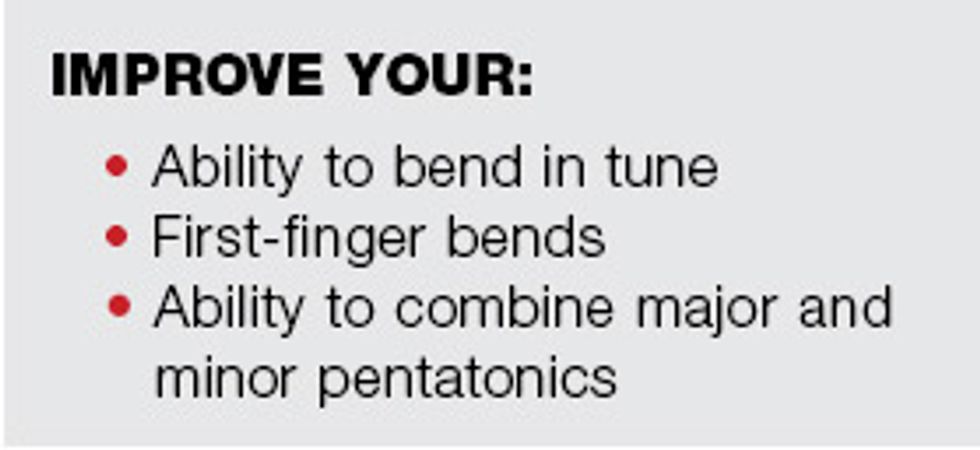I’ve always been inspired by the great
electric slide players. Guitarists like
Elmore James, Ry Cooder, Duane Allman,
Lowell George, and Bonnie Raitt tear me
up with the emotional power in their lines.
As I learned to play, the command of the
blues and level of expression these players
possessed far surpassed anything I could do
with an ordinary fretted guitar using left-hand
fingers. The fluidity of my own bending
could never match the aching emotion
of sliding into a note. I still feel jealous
when I trade solos with a good slide player!
I set out relearning the classic Duane Allman’s Live at the Fillmore intro to “Statesboro Blues,” note for note, without a slide. One way I’ve always practiced is to learn a solo and then play it along with the CD until my phrasing matched perfectly. I’ve done this with everyone from Eric Clapton’s “Crossroads” to Miles Davis’ “Freddy the Freeloader.” Try it! Learn a solo like Albert King’s “Crosscut Saw” and try to nail his phrasing. It’s impossible—because nobody else plays like that—but the exercise and application of his technique makes you a better player. In the last few years I’ve started applying this practice method to slide guitar solos. The first thing I noticed was that my standard fingering had to change.
The first lick shown in Fig. 1 is in the style of Duane Allman. To get the phrasing right, your first finger will need to do all the heavy lifting. Start in the 9th position using your second and third fingers for the A and F#, respectively. Then use your first finger to bend up to Ab and release down to G. In the next measure, pre-bend up to D using your second finger, release down to C and play A with your third. Use your already overworked first finger to pre-bend up a half step to Ab, release to G, and play F and D in the 12th position on the 4th string. Once you get it under your hands, you’ll be phrasing like a slide player, but the real benefit is the new world of alternative bending licks.
Download Example Audio...

Fig. 2 is a great blues lick in the tradition of Duane Allman, which I learned off a Derek Trucks recording. Combining major and minor pentatonics in a single line is a favorite sound of mine. Over an E blues progression, play this over the I chord using your first finger to bend the A up to B on beat 2. Notice the use of both major and minor 3rds.
Download Example Audio...

Unlike Duane who played mostly in open-E tuning, Little Feat’s Lowell George played in open-G tuning. (A helpful hint: When playing slide using both tunings, relate to the two in terms of where the minor third sits. In open E, it’s between the 2nd and 3rd strings; in open G, it’s between the 1st and 2nd. This will help when switching between tunings.) Fig. 3 combines a few different bends in order to make the typical pentatonic stuff sound different and interesting. This easy lick is all about phrasing. You need to practice making it sound like a slide player—fluid and graceful.
Download Example 3...

Remember, the slide rarely leaves the neck during the execution of these lines, so our fingers should mimic that kind of continuous expression. Incorporating your fourth finger into bending gives you the ability to work all four digits into the mix. And that makes you a stronger player!
 Carl Verheyen has been one of the most indemand
session musicians on the L.A. scene
for the past 25 years. Since 1985, he has been
a member of British rock group Supertramp.
As an educator, Verheyen has released two
instructional books and regularly teaches
clinics on the road. For more information,
visit carlverheyen.com.
Carl Verheyen has been one of the most indemand
session musicians on the L.A. scene
for the past 25 years. Since 1985, he has been
a member of British rock group Supertramp.
As an educator, Verheyen has released two
instructional books and regularly teaches
clinics on the road. For more information,
visit carlverheyen.com.
I set out relearning the classic Duane Allman’s Live at the Fillmore intro to “Statesboro Blues,” note for note, without a slide. One way I’ve always practiced is to learn a solo and then play it along with the CD until my phrasing matched perfectly. I’ve done this with everyone from Eric Clapton’s “Crossroads” to Miles Davis’ “Freddy the Freeloader.” Try it! Learn a solo like Albert King’s “Crosscut Saw” and try to nail his phrasing. It’s impossible—because nobody else plays like that—but the exercise and application of his technique makes you a better player. In the last few years I’ve started applying this practice method to slide guitar solos. The first thing I noticed was that my standard fingering had to change.
The first lick shown in Fig. 1 is in the style of Duane Allman. To get the phrasing right, your first finger will need to do all the heavy lifting. Start in the 9th position using your second and third fingers for the A and F#, respectively. Then use your first finger to bend up to Ab and release down to G. In the next measure, pre-bend up to D using your second finger, release down to C and play A with your third. Use your already overworked first finger to pre-bend up a half step to Ab, release to G, and play F and D in the 12th position on the 4th string. Once you get it under your hands, you’ll be phrasing like a slide player, but the real benefit is the new world of alternative bending licks.
Download Example Audio...
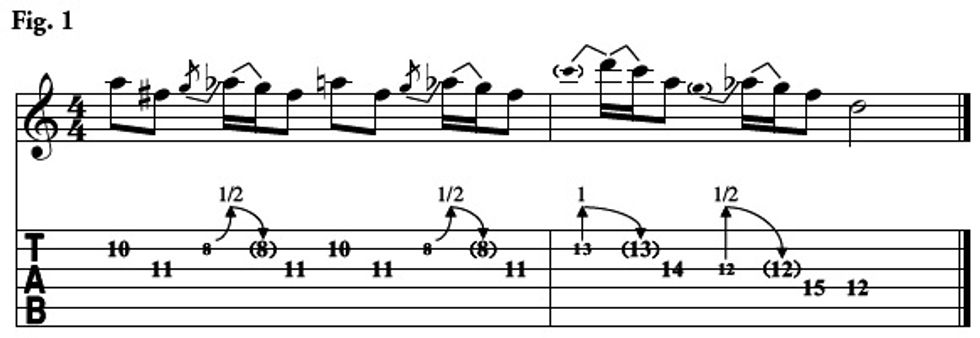
Fig. 2 is a great blues lick in the tradition of Duane Allman, which I learned off a Derek Trucks recording. Combining major and minor pentatonics in a single line is a favorite sound of mine. Over an E blues progression, play this over the I chord using your first finger to bend the A up to B on beat 2. Notice the use of both major and minor 3rds.
Download Example Audio...
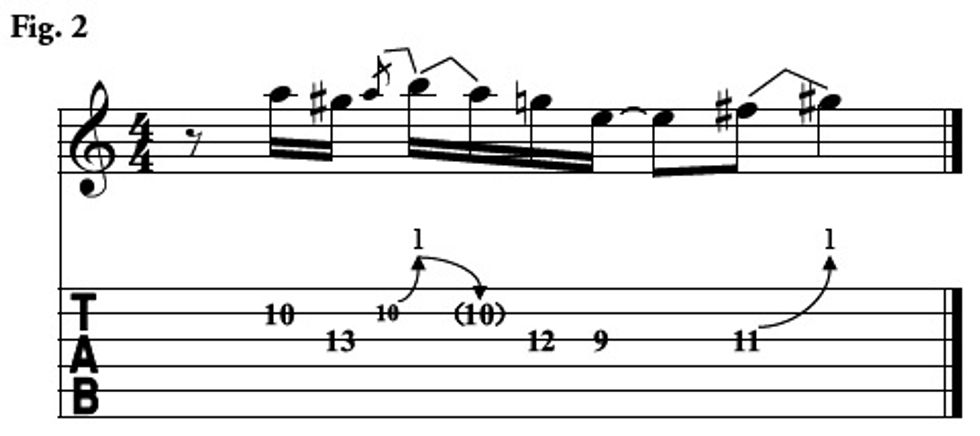
Unlike Duane who played mostly in open-E tuning, Little Feat’s Lowell George played in open-G tuning. (A helpful hint: When playing slide using both tunings, relate to the two in terms of where the minor third sits. In open E, it’s between the 2nd and 3rd strings; in open G, it’s between the 1st and 2nd. This will help when switching between tunings.) Fig. 3 combines a few different bends in order to make the typical pentatonic stuff sound different and interesting. This easy lick is all about phrasing. You need to practice making it sound like a slide player—fluid and graceful.
Download Example 3...
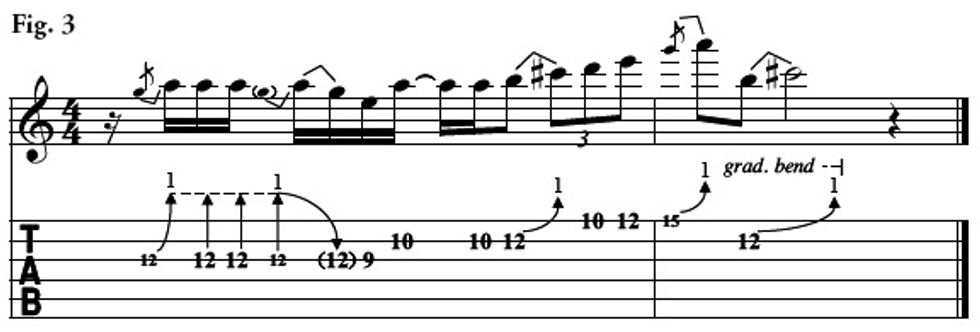
Remember, the slide rarely leaves the neck during the execution of these lines, so our fingers should mimic that kind of continuous expression. Incorporating your fourth finger into bending gives you the ability to work all four digits into the mix. And that makes you a stronger player!
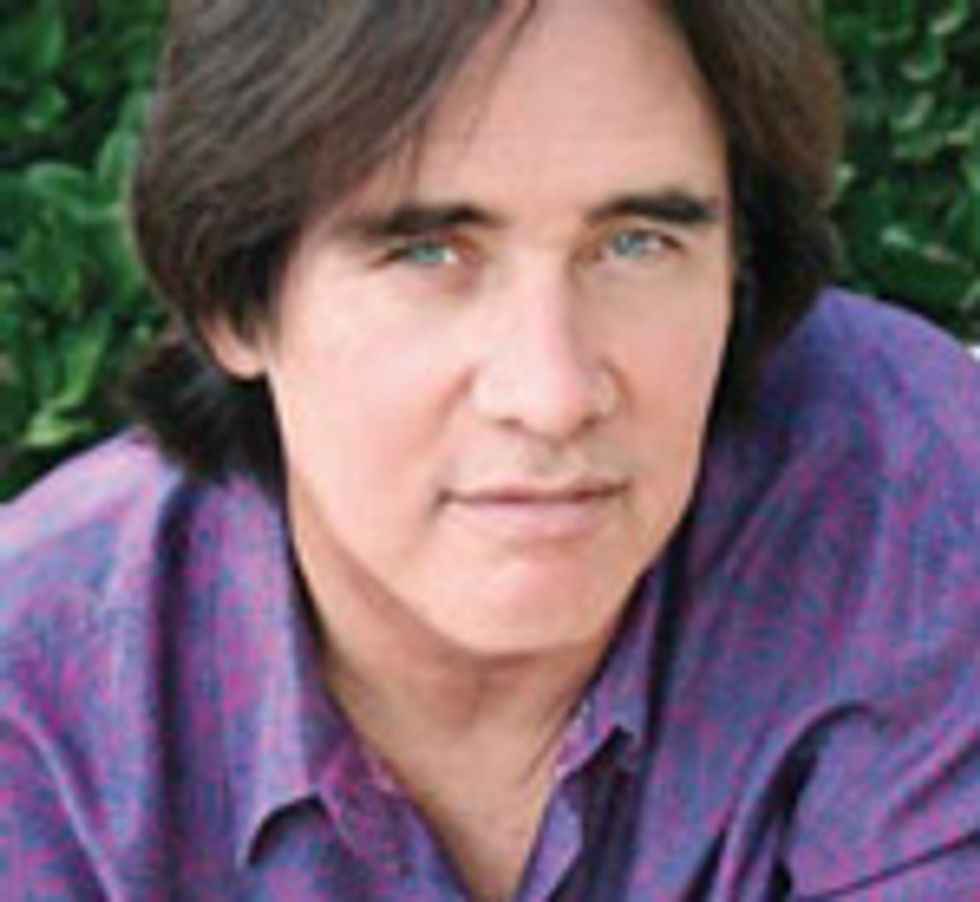 Carl Verheyen has been one of the most indemand
session musicians on the L.A. scene
for the past 25 years. Since 1985, he has been
a member of British rock group Supertramp.
As an educator, Verheyen has released two
instructional books and regularly teaches
clinics on the road. For more information,
visit carlverheyen.com.
Carl Verheyen has been one of the most indemand
session musicians on the L.A. scene
for the past 25 years. Since 1985, he has been
a member of British rock group Supertramp.
As an educator, Verheyen has released two
instructional books and regularly teaches
clinics on the road. For more information,
visit carlverheyen.com.

